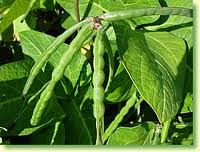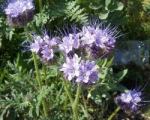Guest post by Kelly Scott of Sweet Bay Farm. Thanks Kelly!
The more I learn about farming, the more I realize that plants are truly wondrous things. It’s easy to think plants are boring and passive. After all, they just sit there.
But here’s some news! Plants are powerful chemists and very active participators in their environment. On our farm, we now see plant properties and behaviors as a tool for rejuvenating our dead soil. Here’s what we’ve learned so far.
Plants Leak Yummy Exudates
Plants make a lot of sugars and other compounds from photosynthesis, and instead of using them all for energy, they leak a lot of them from their roots to attract and stimulate soil microbes. These compounds are called “root exudates”.

Plant root exudates: "Signaling molecules" that stimulate beneficial bacteria and fungi. Marschner, 1995.
Every plant variety leaks its own signature of chemicals in the form of amino acids, carbon, and organic acids to attract the beneficial soil microbes it needs to live and thrive. Plants actively modify their environment and build their own microbial community in the soil!
Plants leak a lot of chemicals. These chemical compounds are signs of welcome and warning. Most of the compounds are welcome chemicals that attract a very beneficial and helpful bacteria and fungi community that like the plant’s exudates and promote its growth. Plants also leak warning compounds to keep themselves safe from soil herbivores and other threats.
Exudates Can Improve Soil
Farmers and gardeners can take advantage of plant exudate properties to improve soil and grow food that’s very nutritious. Filling the soil with many diverse plants that have shallow, medium, and deep roots will take advantage of the fact that all plants leak different compounds that will stimulate different segments of soil’s beneficial biology.
The soil on our farm has a long way to go before it is truly fertile with a fully restored biology. We need a diverse soil biology community, so we plan to improve the soil by planting from many different plant categories:
Legumes

Cow peas (black eyed peas): one of the best legumes for building soil.
Mycorrhizae are amazing symbiotic fungi that work wonders for the soil. They go for maximum carbon exudates from the plant. To get what they want, they boost the plant’s photosynthesis by conferring drought resistance and bringing phosphorus, copper, zinc, manganese and other ions and amino acids to the plant.
By making the plant healthier, they get even more carbonaceous exudates from their host. Mycorrhizae turn a lot of it into glomalin, a significant carbon component in the soil that helps glue soil particles together and form wonderful aggregates that let more air and water percolate through the soil. Legumes are clearly a win-win-win for soil.
Corn and Warm-Season Grasses
Corn, warm-season grasses and broadleaves such as sunflowers leak massive amounts of exudates. They are trying to attract a large, diverse microbe community for protection and growth promotion, including lots of mycorrhizae (myco). So this plant category can also stimulate lots of soil biology and sequester quite a bit of carbon via myco.
Brassicas

Mustard, a great brassica for improving soil.
Brassicas such as mustards, radishes, broccoli, kale, etc. are different. They do not associate with myco. Instead, they leak some rather harsh acids. They don’t need myco to go get soil minerals because they can use acids to get it for themselves.
Brassicas’ acid exudates can cleave off calcium that is tightly bound to phosphorus in the soil. The brassica plant then soaks the phosphorus right up. That’s why planting brassicas is a good method for “mineralizing” tightly bound phosphorus and making it available for the next plants that grow as the brassica decomposes.
Brassicas also stimulate the middle of the soil food web, arguably the most important part – the mites, earthworms, and other recyclers that prey on bacteria and fungi to keep them in a healthy balance. Multiple studies show that, for some reason, brassicas make earthworms and other soil animals go really nuts in a good way.
So brassicas are key for mineralizing hard to get soil minerals and for stimulating the very important soil animals.
Alfalfa and Sweet Clover
Deep rooted plants such as alfalfa and sweet clover can bring up fertilizers from long ago that have leached deep into the soil profile. The long roots also make channels for earthworms and other beneficial biology to travel. The channels provide for better air and water percolation which fights compaction and improves soil structure.
Pollinators
Flowers like phacelia have nice, fine roots with lots of fungi. As pollinators, they can attract more above-ground diversity to the farm or garden.
Soil Improvement Plan
On our farm, we’re going to improve the soil by growing a big cover crop cocktail. We’ve ordered a seed mix that includes several varieties from each category mentioned above.
We’re really excited to see how the cocktail grows. With the big diversity of plants and flowers, I’m hoping it will be super pretty. As late summer nears, we hope to see more wildlife and insects and good water retention. And as all the different plants stimulate all parts of soil life, we should see our subsequent crops growing much better.
Cover cropping isn’t just for farmers – it’s a great technique for limited-space gardeners, too! Do you use cover crops or take advantage of root exudates in your garden to build your soil quality?
Passionate gardener Kelly Scott farms with her husband in Southern Maryland. Their land’s beauty was diminished by dusty soil from 150 years growing tobacco and a decade growing GMO soybeans. Faced with this soil challenge, Kelly became keenly interested in how to bring dead soil back to life. She still has many questions but is convinced that plants, particularly dense and diverse cover crops, are the key to restoring humus and beneficial biology to the soil. She blogs at Sweet Bay Farm.




Great article- I always plant sunflowers in my veggie beds, so I’m happy to learn that my whimsy is scientifically justified!
What a fun post! I’d love to know which cover crop mixture Kelly is planting. I’ve grown cover crops for a few years and those parts of my garden always perform best.
Hi there! We’re about to plant a big mixture in a few weeks in our fields. I tried to get my hands on just about every warm-season affordable seed. Grasses include sorghum and different millets. Legumes: sweetclover, sunn hemp, cowpeas, soybeans, hairy indigo, alfalfa. Brassicas: camelina, mustard, turnips, dwarf essex rape. Broadleaves: sunflowers, chicory, buckwheat, phacelia, and other insectary plants like dill, coriander, wild flowers. Will set some of this mix aside for some of my veggie beds too. I’ll blog more about this mix in a couple of weeks.
Beautiful and amazing. Thank you for passing this along .
I read David Holmgren’s Permaculture book (I had to wait a while for my turn, it’s popular at the library). And I’ve been paying close attention to his advice to observe carefully the natural way mother nature cares for her soil. I’ve read that a farmer or gardener should shudder to see bare soil, so I’ve started using weeds as signs and helpers in the yard (within reason). I lot of things growing here are volunteers that could have been mistaken for a weed like forget-me-nots, rose champion, parsley, foxgloves . . . Weeds I know will not be hard to remove when I’ve ready to use that space for something else I leave. Weeds like grass and dandelions I remove wherever I see them. It’s disturbs the soil less and I think that helps build soil life.
Arrianne, the Back to Eden film that Erica recommended https://nwedible.com/2012/04/while-im-away-check-these-out.html also discusses not having bare soil. The images are compelling!
that was great to read in details what all the different crops do. I was telling my daughter that my veggies were going to be very good this year since i have so many worms they are virtually growing in worm poo. She kindly suggested that this might not be such a selling point to every (only other gardeners 🙂
All I could think of reading this article is what a great opportunity to pasture your chickens! My little flock would be in Heaven if they were rotated through areas like what your creating. Just think of all that wonderful chicken shit deposited widely and encouraging the growth of your cover crop until the next time the flock comes through.
Max
Max,
I’ve been thinking about that too! Chickens would love this salad bar. One thing though – we plan to let this cover crop grow as tall as possible to reap the benefits (nice shade for the understory, max rain capture, etc.) don’t chickens prefer low-growing grasses and such?
My Chickens love everything. I found out the hard way this past week, I (really my granddaughter but we don’t want to discourage her from visiting the chickens) left the gate open to the run and my girls stripped my fruit trees practically bare in about an hours time. Granted my trees were cut off at 18″ but the new growth had made it up to 2′ and they got the tips on every branch. It would work perfect in your situation with a small flock, half a dozen hens, that were moved to a new area every couple of days. But anyone who has chickens knows that theres no such thing as a small flock! 🙂
Today the hens managed to climb under the mesh covering my hugelkultur beds. They scratched out or ate half of two beds of 6″ high corn, assorted winter squash and beans. We were dang close to barbecue chicken for dinner. Instead the more official chicken fencing went in today. The girls are wonderful, but infuriating sometimes too.
After reading your Half Assed Hugelkulture Blog about making these beds I decided to combine Square Foot Gardening and Huglkulture in between the rows in my Orchard. In fact I was probably in the process of half-assing my beds at the same time your chickens were ripping up your beds! My problem now is the flock of pigeons my neighbor feeds, I think my chickens taught them about fresh greens! I had to put chicken wire over all of my sunken beds that I was trying to grow chicken forage in because the pigeons were snatchin the new shoots as soon as they broke the ground.
I haven’t but I love the article. It reminds me of methods used by the native Utahns before pioneers. They would plant different crops around there corn for higher yields. My memory is not great but it seemed like it was corn and squash and corn and beans. The corn also became a support pole.
This is fascinating! I never quite understood how the whole legume nitrogen fixing thing worked. And I never knew brassicas and sunflowers were so beneficial. I’m glad I have lots of them in my garden!